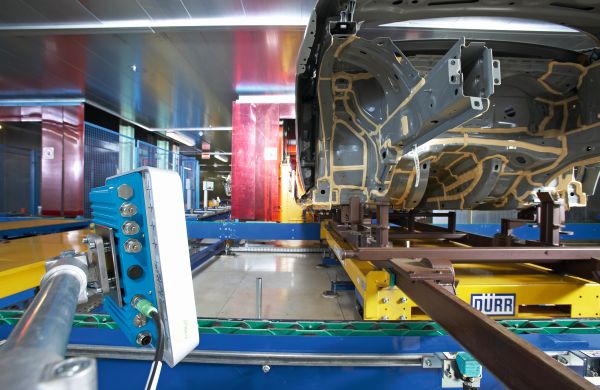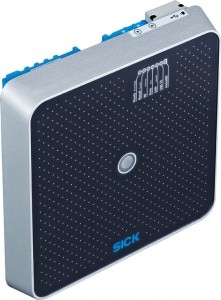Ceilings, walls, floors, skids, and car bodies - there's nothing but metal behind the CPD dryer 2 at Mercedes-Benz in Rastatt. The conditions in which the SICK UHF-RFID devices for wireless identification of the B-Class car bodies have to work are extremely adverse. The devices control the movement of the car bodies, which are identified by a transponder, through the various work stations and processing stations and on to final assembly. With approximately 350,000 readings per day in the system, reading accuracy is a must, since erroneous readings can lead to car bodies being misdirected or mixed up. There is even the risk of collisions.

Fault-free and reliable handling of the car bodies relies on the ability to detect if a car body is a B-Class body which is already being prepared for production. Why is this? When no reads occur, the conveyor system halts and it may lead to rejection. When there are read errors, there is a risk of the bodies getting mixed up. The system may supply the wrong bodies or there may be a risk of collision or misdirection. When selecting the right RFID solution, the iPoint that is the most difficult to read defines the performance requirements to be met by the read/write devices. At Mercedes-Benz in Rastatt, this iPoint is located on the conveyor system behind the CDP dryer 2. After pretreatment by degreasing, rinsing, and phosphating in huge spray systems and further to cathodic dip painting, the bodies are dried in an oven at approx. 180 °C.
They are then staged in random order on a skid conveying line in three lines for subsequent processing steps (seam welding by robots, for example). The area behind the dryer is pure metal: walls, ceilings, floors, conveyor systems, and the numerous car bodies - everything is made of metal. For many RFID systems, this equates to pure stress, because the high-frequency reflections from the system can impair data transmission between the transponders and the read/write devices.
The SICK RFID system: Peak reading rates in excess of 99.98%
 The RFU630 read/write devices are put to the test at a total of 24 identification points, where they must meet the most challenging requirements where availability and reading accuracy are concerned. At Mercedes-Benz in Rastatt, they are integrated with PROFIBUS-DP via external CDF600 fieldbus modules. Ease of configuration and operation with the SOPAS programming software also speak for the RFU630 read/write device. Moreover, should a device need to be replaced, parameter cloning via MicroSD card minimizes time and costs. To achieve maximum reading accuracy in an environment of metal behind the CPD dryer 2, the maintenance technicians at Mercedes-Benz and the application specialists at SICK have configured the read/write devices based specifically on the iPoint. In each case, the reading range has been optimized to the actual distance to the transponder, i.e., reduced to between 0.4 and 1.2 m. As a result, both output and sensitivity have been optimized. When a reading is taken, the body stops briefly so that largely constant environment or transmission and reflection conditions can be achieved. For accurate reading and writing, functions have been shifted to the unit and, for diagnostic reasons, partially implemented on the jointly developed function block. Inaccurate reading? Inaccurate display! Only the car body that is actually at the iPoint is identified - with a confirmed reading accuracy in excess of 99.98%.
The RFU630 read/write devices are put to the test at a total of 24 identification points, where they must meet the most challenging requirements where availability and reading accuracy are concerned. At Mercedes-Benz in Rastatt, they are integrated with PROFIBUS-DP via external CDF600 fieldbus modules. Ease of configuration and operation with the SOPAS programming software also speak for the RFU630 read/write device. Moreover, should a device need to be replaced, parameter cloning via MicroSD card minimizes time and costs. To achieve maximum reading accuracy in an environment of metal behind the CPD dryer 2, the maintenance technicians at Mercedes-Benz and the application specialists at SICK have configured the read/write devices based specifically on the iPoint. In each case, the reading range has been optimized to the actual distance to the transponder, i.e., reduced to between 0.4 and 1.2 m. As a result, both output and sensitivity have been optimized. When a reading is taken, the body stops briefly so that largely constant environment or transmission and reflection conditions can be achieved. For accurate reading and writing, functions have been shifted to the unit and, for diagnostic reasons, partially implemented on the jointly developed function block. Inaccurate reading? Inaccurate display! Only the car body that is actually at the iPoint is identified - with a confirmed reading accuracy in excess of 99.98%.
- Productinformation: Radio-Frequenz-Identification RFH6x
- Customer information: Mercedes Benz GmbH

